-
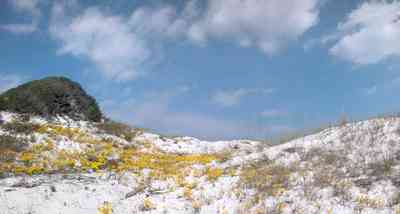
-

The sand scrub pine trees have odd and twisted shapes.
-
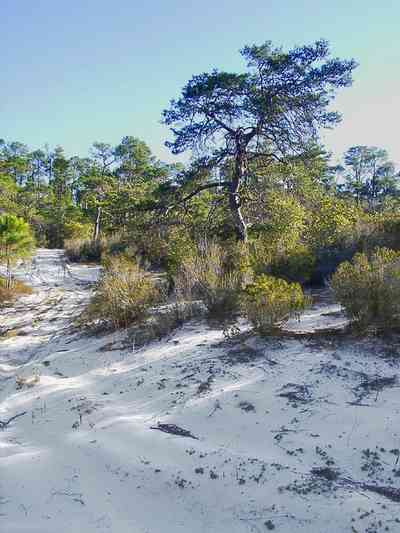
Barrier beaches are one of the world's most restless landforms. As can be seen above the tress are growing on shifting sand which looks like snow.
-
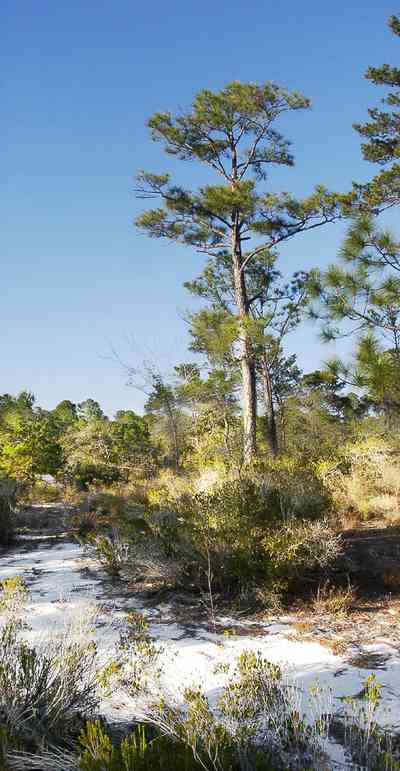
The sand pine forest is located on the sound side of the key on older dunes.
-
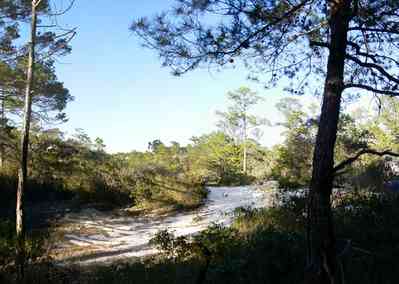
Ridges of old dunes form hills and valleys through the forest.
-
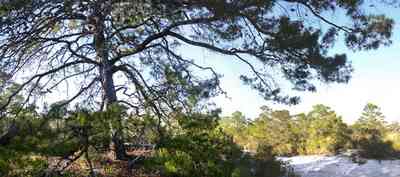
In contrast to the species of pine shown below, the sand pine is much shorter. Its form can be twisted with lower branches growing close to the ground.
-
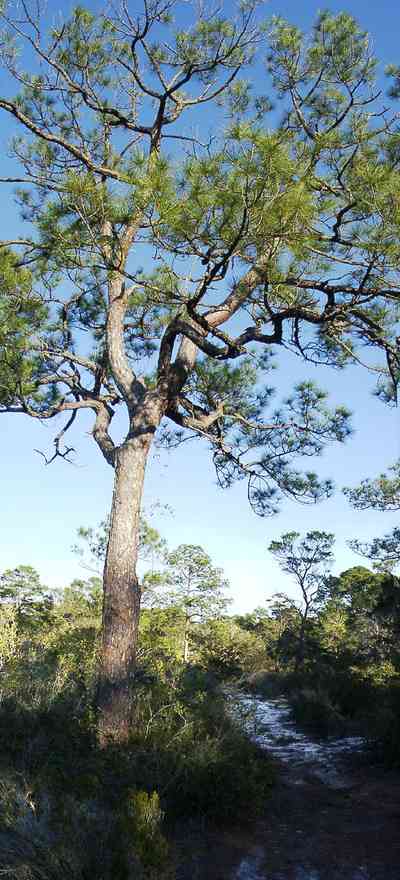
The overstory in some locations is composed of an older growth of short-leafed pine tree.
-
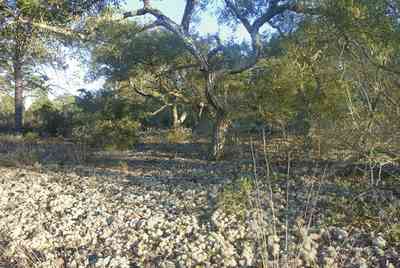
A myrtle oak is surrounded by a lichen ground cover.
-
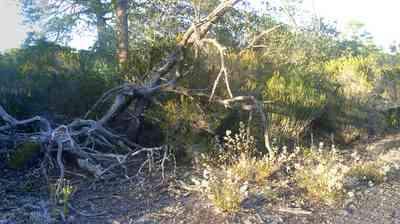
Twisted shapes of dead scrub pines litter the forest floor.
-
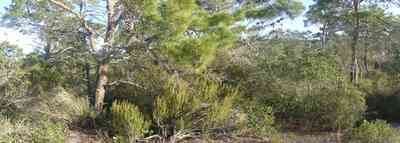
The forest supports a variety of plants and trees in a typical open coastal wood.
-
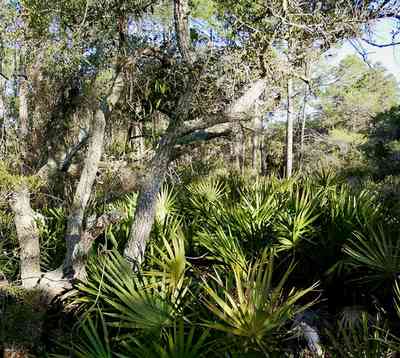
Saw palmettos form a dense groundcover in part of this forest community.
-

A variety of lichen and moss are the most common ground cover.
-

Pieces of pine scrub trees decay slowly because of the high content of sap.
-
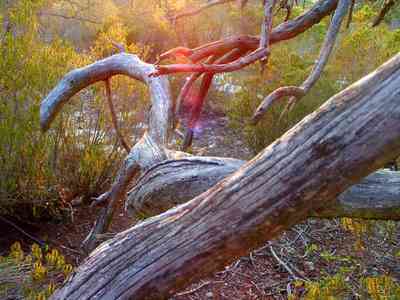
The shapes of the dead pine trees form a natural barrier in the undergrowth of Florida rosemary.
-
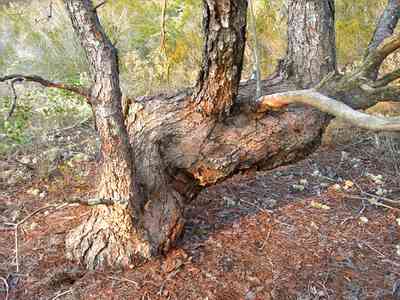
The trunks of the sand pine trees twist and turn into bizarre shapes.
-

The colors of Florida rosemary compliments the green lichens and mosses.
-
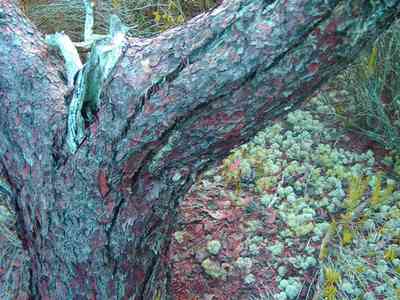
Lichens and mosses grown on the scrub pine trucks.
-
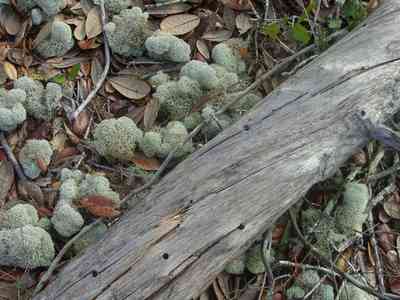
The lichens are like puff balls was they absorb water. Under dry conditions, the same lichens flatten and become dry and brittle.
-

Pine branches forms litter the forest floor.
-
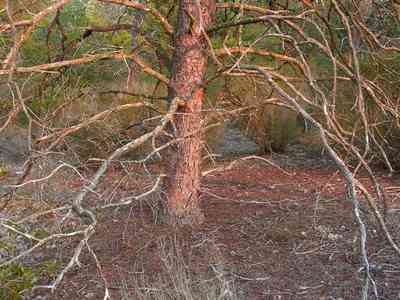
Some of the sand pines have pinwheel shapes.
-
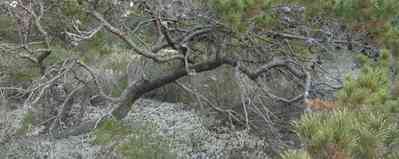
Lichen grow in shaded areas of the sand scrub forest.
-

The number of trees and shrubs inhabit these typical communities of slash pine lowlands and hardwood swamps along the Perdido River.
-

The sand pine scrub is a xeric, or exceedingly, dry, sandy community with a sparse understory of shrubby, evergreen oaks and an overstory of the sand pine.


 The sand scrub pine trees have odd and twisted shapes.
The sand scrub pine trees have odd and twisted shapes. Barrier beaches are one of the world's most restless landforms. As can be seen above the tress are growing on shifting sand which looks like snow.
Barrier beaches are one of the world's most restless landforms. As can be seen above the tress are growing on shifting sand which looks like snow. The sand pine forest is located on the sound side of the key on older dunes.
The sand pine forest is located on the sound side of the key on older dunes. Ridges of old dunes form hills and valleys through the forest.
Ridges of old dunes form hills and valleys through the forest. In contrast to the species of pine shown below, the sand pine is much shorter. Its form can be twisted with lower branches growing close to the ground.
In contrast to the species of pine shown below, the sand pine is much shorter. Its form can be twisted with lower branches growing close to the ground. The overstory in some locations is composed of an older growth of short-leafed pine tree.
The overstory in some locations is composed of an older growth of short-leafed pine tree. A myrtle oak is surrounded by a lichen ground cover.
A myrtle oak is surrounded by a lichen ground cover. Twisted shapes of dead scrub pines litter the forest floor.
Twisted shapes of dead scrub pines litter the forest floor. The forest supports a variety of plants and trees in a typical open coastal wood.
The forest supports a variety of plants and trees in a typical open coastal wood. Saw palmettos form a dense groundcover in part of this forest community.
Saw palmettos form a dense groundcover in part of this forest community. A variety of lichen and moss are the most common ground cover.
A variety of lichen and moss are the most common ground cover. Pieces of pine scrub trees decay slowly because of the high content of sap.
Pieces of pine scrub trees decay slowly because of the high content of sap. The shapes of the dead pine trees form a natural barrier in the undergrowth of Florida rosemary.
The shapes of the dead pine trees form a natural barrier in the undergrowth of Florida rosemary. The trunks of the sand pine trees twist and turn into bizarre shapes.
The trunks of the sand pine trees twist and turn into bizarre shapes. The colors of Florida rosemary compliments the green lichens and mosses.
The colors of Florida rosemary compliments the green lichens and mosses. Lichens and mosses grown on the scrub pine trucks.
Lichens and mosses grown on the scrub pine trucks. The lichens are like puff balls was they absorb water. Under dry conditions, the same lichens flatten and become dry and brittle.
The lichens are like puff balls was they absorb water. Under dry conditions, the same lichens flatten and become dry and brittle. Pine branches forms litter the forest floor.
Pine branches forms litter the forest floor. Some of the sand pines have pinwheel shapes.
Some of the sand pines have pinwheel shapes. Lichen grow in shaded areas of the sand scrub forest.
Lichen grow in shaded areas of the sand scrub forest. The number of trees and shrubs inhabit these typical communities of slash pine lowlands and hardwood swamps along the Perdido River.
The number of trees and shrubs inhabit these typical communities of slash pine lowlands and hardwood swamps along the Perdido River. The sand pine scrub is a xeric, or exceedingly, dry, sandy community with a sparse understory of shrubby, evergreen oaks and an overstory of the sand pine.
The sand pine scrub is a xeric, or exceedingly, dry, sandy community with a sparse understory of shrubby, evergreen oaks and an overstory of the sand pine. One Tank of Gas
One Tank of Gas